Chapter
Five Part Three
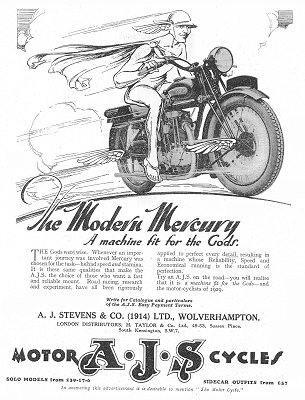 |
The Mention of Clarrie
Wise reminds me that like Sunbeam's George Dance he was not
really a road racing man. Clarrie's forte being trials. He was a
member of the A.J.S. team in many international events
collecting gold medals and silver cups galore.
Soon after the
Isle of Man races Jack Emerson had a brace of HRDs at
Brooklands, winning the 200 mile race at 84.27m.p.h. The
Italian Grand Prix fell to Achillie Varzi riding a
Sunbeam and the 350c.c. and 500c.c. classes of the
French Grand Prix fell to A.J.S.
Nearer home
again and to the Ulster Grand Prix, no longer a handicap
race. 1926 brought good results for Wolverhampton
machines for the first time Sunbeam’s Competitions
Manager Graham Walker won the 500c.c. race at
70.43m.p.h., also setting a record lap of 75m.p.h.
|
| Team mate Tommy Spann took second
place whilst Charlie Dodson claimed third spot in the
350c.c. race on his Sunbeam.
There were some changes to the 1926 Amateur T.T. The
race distance had been increased from 5 to 6 laps, a
distance now of 227 miles. Everyone enjoyed good weather
for the practice period but then came the rains and race
day dawned with roads awash and the dreaded mist on the
Mountain. The race proved a runaway for “A. Reserve”,
the non de plume of Rex Adams. He adopted it so that his
parents would not know he was racing until it was all
over.
Adams or “A.
Reserve” rode an A.J.S. and led by 28 seconds at the end
of the first lap. He increased his advantage on each lap
to finish 12 minutes 8 seconds ahead of M.I. Dawson’s
HRD. D. Oldroyd took 3rd place on a Sunbeam. The
winner’s time of 3 hours 52 minutes 23seconds at an
average speed of 58.46m.p.h. was a good performance in
the truly terrible weather conditions. The winner also
made the fastest lap of 61.76m.p.h.
Whilst the only
A.J.S. in the race had proved to be the winner, there
were numerous other Wolverhampton made machines in the
race. Riders of HRDs claimed 2nd, 9th and 21st places
and Sunbeams came 3rd, 5th, 10th, 11th, 12th, 13th, 17th
and 19th. All told it proved to be a very good race for
the riders of Wolverhampton made machines.
You may have noticed
that no mention has been made of Len Randles. It will be
remembered that he won the first two Amateur T.T.s and looked
like doing it again the following year until mechanical bothers
forced him out. He had also ridden very well in the June T.T.
Whilst returning from a trial he met with a serious road
accident and was badly injured. The injuries ended his racing
career, which was a great pity as he was a rider of tremendous
ability and could well have become a member of one of the
leading works teams.
|
| Before moving on to the year 1927
we shall look at something that might have been.
Although Villiers supplied engines in very large
quantities to many motorcycle manufacturers, both at
home and abroad, they were not to produce complete
machines. No doubt from time to time they considered
doing so, but perhaps felt it best not to compete with
their customers. All that is quite well known, but what
is not so well known is the fact that around 1926
Villiers considered producing a car. |
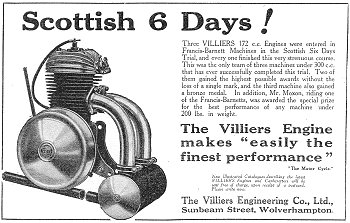
An advert from 1926. |
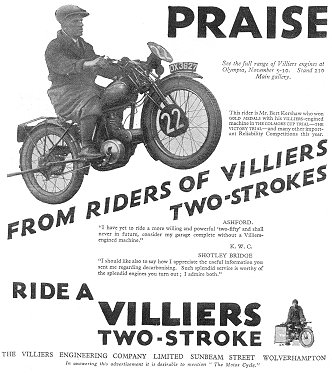 |
Leslie Farrar, nephew of
the Wolverhampton concerns Managing Director Frank Farrar left
his employment at the Austin Motor Company to work on the
project. A medium size six cylinder vehicle of good quality was
envisaged that would sell at a reasonable price.
Some experience
was gained by visits to factories in America, where it
was learned that mass produced engines could be supplied
at a very low prices, for example six cylinder engines
could be supplied at around £28 per unit.
In the event
three prototype cars were built and road tested and they
proved quite satisfactory, but the state of the industry
at that time caused Villiers to think again and the idea
was dropped.
|
| All was not lost however, for
Leslie Farrar stayed on and when his uncle retired he
took over as Managing Director and led the company to a
very successful future.
Now to 1927 and a look at Sunbeam. As noted above, cash
difficulties had curtailed the Wolverhampton factory’s
racing programme. Coatalen was still responsible for the
group’s competition activities. Talbots would still be
racing and Coatalen was keen to keep the Sunbeam name in
the limelight, and so he and his staff cast around for
ideas to accomplish this. Sunbeam had held the land
speed record three times and on the last occasion with a
12 cylinder 4 litre car pushing it to l53.33m.p.h. This
took place in March 1926 and was the first car to travel
over 150m.p.h. It had been driven by Henry Seagrave, but
a few weeks later the record was broken by Parry Thomas
at Pendine Sands. He reached 169.3m.p.h. and on the
following day, April 28th, he tried again and
increased his speed to over 170m.p.h.
Whilst the
Sunbeam and previous record cars had been quite
conventional racing cars Thomas's car “Babs” was very
special, being powered by a 27 litre Liberty aeroplane
engine. This heralded the end of the “ordinary” record
breaker, from now on they would be monsters.
Perry Thomas’s
record of 171.02m.p.h. stood until February 1927 when
Malcolm Campbell took his latest “Bluebird” to Pendine.
The car was powered by a 22 litre l2 cylinder 450h.p.
Napier “Lion” aeroplane engine and he pushed the record
to 174.8m.p.h.
Whilst all this
had been going on a very special record breaker was
under construction at Sunbeam, and this was really a
monster. During the last months of 1926 Louis Coatalen
had decided to put the Sunbeam name forward to take the
land speed record again. Sunbeam had built the first car
to exceed 150m.p.h. and now the sights were on 200m.p.h.
This was a very ambitious plan but calculations had
shown that it could be done, if tyres could be made to
withstand such speeds. As so often Dunlop got down to it
and of course did produce suitable tyres. |
| The Sunbeam LSR car which became
known as the 1,000 h.p. had two ‘V’ 12, 22.5litre
435h.p. Sunbeam “Matabele” aeroplane engines. The design
had been sketched out by Coatalen and then handed over
to Captain Irving to develop. |
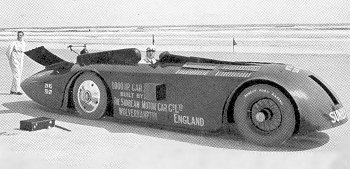 |
|
The engines had cylinder
dimensions of l22 x l60mm and were mounted one in front and one
behind the driver. They had two overhead camshafts to each bank
of six cylinders and there were eight BTH magnetos firing two
plugs per cylinder. The engines were fitted with four Claudel
carburettors and the car weighed 3.5 tons.
The starting
procedure was quite complicated. The rear mounted engine
was first started by compressed air and when running a
friction clutch engaged, coupling it to the front engine
and a positive dog clutch was engaged. There was a
geared up drive to a massive three speed gearbox and a
final drive to the rear wheels by side chains. The whole
chassis was enclosed in a streamlined body, the first of
its kind. For the record attempt the rear wheel covers
where removed to help cool the rear tyres. Though known
as the 1,000h.p., an excellent publicity figure gave the
actual power at around 870h.p. at 2,000r.p.m. |
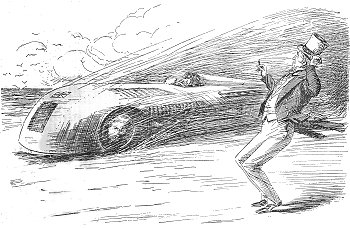 |
A massive test rig had
been constructed in the experimental department at the Moorfield
Road works and tests proved satisfactory. The question now arose
of a suitable venue for the attempt, as both Pendine and
Southport were considered unsuitable. After a lot of discussion
the choice finally fell on Daytona Beach, situated in Florida.
This had been the choice of Henry Seagrave who would be driving
the car.
|
|
The car and personnel
travelled on the “Berengaria” and during the voyage they heard
the tragic news that Parry Thomas had been killed whilst making
a record attempt at Pendine. This could have been disturbing for
the Sunbeam party as it was reported that the accident had been
caused by the breakage of a driving chain. The Sunbeam also had
chain drive, but on “Babs” the chains were only protected by a
thin metal cover, whereas on the Sunbeam they were enclosed in
armoured cases. None the less prior to the record attempt they
were very thoroughly inspected, and incidentally when on the
test rig at the works the chains had run red hot.
The team arrived in
America and travelled directly to Daytona where the record
attempt was due to be made on March 20th. At about
10a.m. Seagrave started on his first run and what a thrilling
sight it must have been as the great red car streaked down the
course with its driver only just able to keep it under control.
At the end of the run all the tyres were changed and the car
started back again with Seagrave fighting for control. It had
been a most successful run. The flying kilo had been covered at
202.988m.p.h., the flying mile was at 203.792m.p.h. and the
flying 5 kilometres was achieved at a record speed of
202.675m.p.h. Thus beating the previous record by no less than
28m.p.h., the greatest margin of increase to date. Seagrave went
down in history as the first man to travel at over 200m.p.h. on
land, a very fine and wonderful achievement.
There were many
congratulatory telegrams and messages, one of which came from
Malcolm Campbell, the previous record holder, who was now well
prepared to have another attempt. This he did in 1928 and took
the record by a little over 3m.p.h. Sad to say Sunbeam would not
again hold the record, but happily the car still exists. Louis
Coatalen had wished to gain world wide publicity at little cost,
and this he had done. The car had cost around £5,400 including
labour, most of the expenses of the American trip having been
met by the component manufacturers and sponsors. It had all been
achieved at a fraction of the cost of running a Grand Prix
racing team.
With Sunbeam’s racing
activities curtailed the Wolverhampton cars were not seen in the
big international events, none the less they still featured in
many home events. At Brooklands Kaye Don notched up a number of
successes. In the six hour race three of the 3 litre sports cars
were entered. They were driven by Henry Seagrave, George Duller
and J.W. Jackson/N.Turner. Duller won the race having covered
386 miles. Seagrave retired but the other Sunbeam finished 6th.
At the September Shelsley Walsh Hill Climb the famous mechanic
Bill Perkins took 2nd place in the 2 litre class, driving a 2
litre supercharged six cylinder car and then with the ‘V’ 12
supercharged 4 litre, won the over 3 litre class. |
|
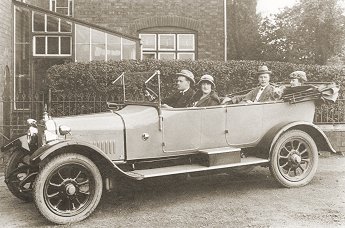
A 1921 Sunbeam 6h.p. tourer. |
For 1927 Sunbeam offered a fine
range of 6 models, all of which had overhead valve
engines. Prices ranged from £550 for the 16h.p. to £1975
for the luxury straight eight 45h.p. car. These
Wolverhampton made cars were among the very best made,
indeed it can be said that the quality was far to good
for the prices asked. Very great care was taken in
manufacture and testing, for example crankshafts were
turned from solid billets of special high grade steel
and gears were ground both sides and then meticulously
tested.
|
| All this cost money, but no one
in charge at Moorfield Road seemed keen to grasp the
nettle and increase prices or try to introduce more
efficient work methods. The former solution would no
doubt have badly effected sales, but it should have been
possible to have organised more economic production
without in any way impairing the quality of the product.
It is a great pity something was not done, for there was
a ready market for all that Sunbeam could produce.
The Star Motor Company were also able to sell all the
cars and commercials produced at the Frederick Street
works, though in much smaller numbers than Sunbeam. More
buildings were being erected at the Bushbury site with a
view to an early move there for all production. During
1927 a number of cars were supplied to King Ibn Saud
including some Harem cars. Also during the year
cellulose finishes were introduced.
The cars offered by Star
included a four seater tourer, with a four cylinder 11.9h.p. ohv
engine and cylinder dimensions of 69 x l30mm. It sold
£4l0. The l8/50 five seater saloon, fitted with a 17.9h.p., six
cylinder ohv, 75mm y 120mm engine cost £850.
For sometime Star had
named their various models after stars, for example the 14/40
side valve four cylinder, two seater was the "Argo" and cost
£410. The "Draco" a five seater tourer was listed at £425 and a
saloon version the "Dorado" cost £475. The cars all shared a
common chassis and engine.
Quite a lot of publicity was made
of the fact that the well known tropical explorer Mrs.
Diana Strickland was to drive a car across Africa at its
widest part and that the car chosen would be a Star. She
left Wolverhampton during May with a 14/40 named "Star
of the Desert”. It was a standard vehicle except that
the body had been fitted out to give some sleeping
accommodation. Mrs. Strickland's journey proved to be a
success having covered 7,236miles over some of the
wildest country in Africa in a running time of 58 days,
though she was away for little over a year. |
| Turning now to Star commercial
vehicles we note that the “Flyer" was introduced. It had
a 24h.p. ohv six cylinder engine with cylinder
dimensions of 80 x 120mm and was said to be the first
overhead valve six to be fitted into a British
commercial vehicle.
Designed to take 20 seater coach
bodywork, it was said to be faster than some of the
cars. During the last three months of 1927, 105 cars and
5 commercials were sent out. |
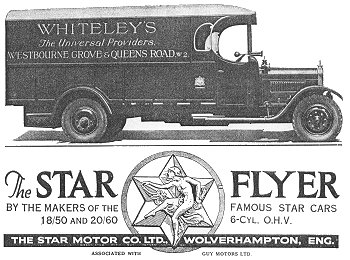 |
| Staying with the commercials, Guy
Motors were being kept busy producing a fine range of
lorries and passenger service vehicles. A forward
control version of their six wheel double deck bus came
out and found many customers, one becoming the first six
wheeled bus to operate in London. A rather out of the
rut vehicle that Guy introduced during 1927 was the
produced gas lorry. The idea was to use the vehicle in
countries where petrol was in short supply and
expensive. Producer gas vehicles were used in limited
numbers during the two world wars and various solid
fuels could be used. In the 1927 Guy system charcoal was
the fuel, but it is recorded that one large British
municipality ran a fleet of Guys on sewer gas. This must
have been a great saving for the rate payers. Quite a
number of the producer gas vehicles were sold and the
customers included the Australian Government and the
Crown Agents for the Colonies. |
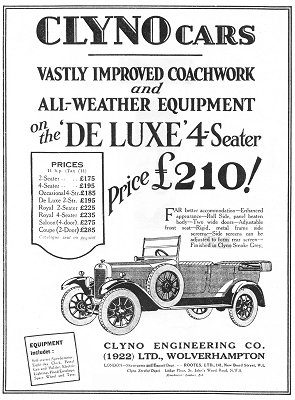 |
Nothing has been said
about Clyno for sometime. This is not to say that nothing was
happening at the Pelham Street works. On the contrary they were
very busy, and whilst the larger Clyno, a competitor to the
Morris Oxford was not doing too well, a smaller model was a
serious competitor for the Morris Cowley.
A fully equipped
four seater saloon now cost £200, which was very good
value. Production stood at around 300 cars per week,
making the Wolverhampton concern the third largest motor
manufacturer in the country. It really is a marvel
how they managed such production in the rather cramped
Pelham Street works. A move to larger premises was afoot
and at the beginning of 1927 Clyno moved to a large new
factory at Bushbury, premises that would later be
occupied by Britool. As well as cars an 8cwt Van was
brought out to sell at £173 and proved quite a success.
|
|
As with their
motorcycles Clyno did not enter cars in speed events. In 1924
they had produced a very nice sports model which had a polished
outside exhaust system and very attractive Swallow bodywork. The
demand for the other models was such that only few of the sports
cars were built.
Clyno did support
reliability trials, often with Frank Smith at the wheel. Jimmy
Crocker also drove in the works team and they enjoyed many
successes as did numerous private owners who entered the various
competitions. |
 |
 |
 |
Return to
Part 2 |
Return to
the beginning |
Proceed to
Part 4 |
|